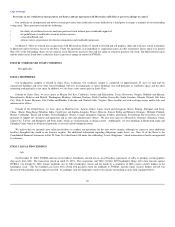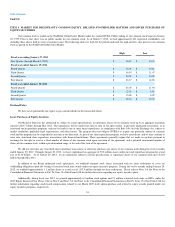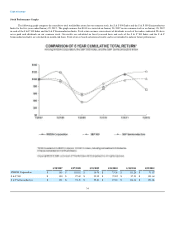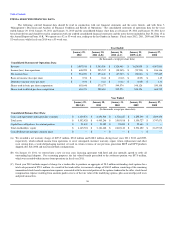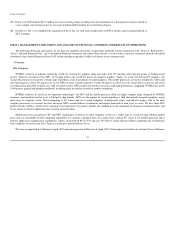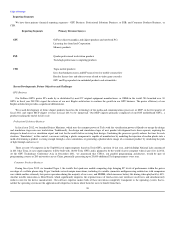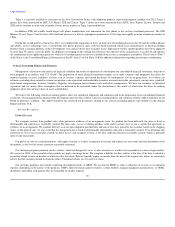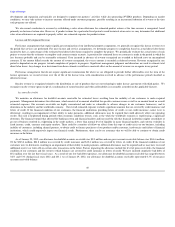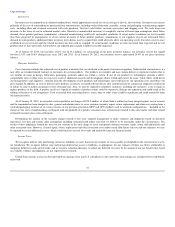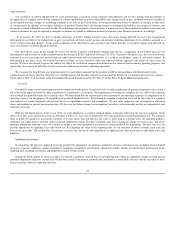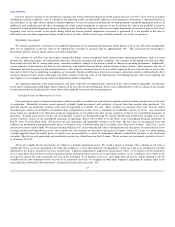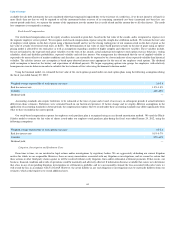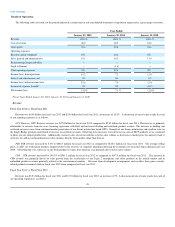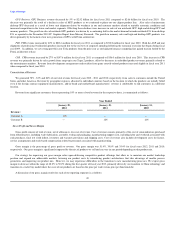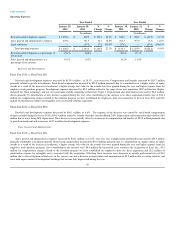NVIDIA 2012 Annual Report Download - page 39
Download and view the complete annual report
Please find page 39 of the 2012 NVIDIA annual report below. You can navigate through the pages in the report by either clicking on the pages listed below, or by using the keyword search tool below to find specific information within the annual report.
Table of Contents
Reporting Segments
We have three primary financial reporting segments - GPU Business; Professional Solutions Business, or PSB; and Consumer Products Business, or
CPB.
Reporting Segments Primary Revenue Sources
GPU GeForce discrete graphics and chipset products and notebook PCs
Licensing fees from Intel Corporation
Memory products
PSB Quadro professional workstation products
Tesla high-performance computing products
CPB Tegra mobile products
Icera baseband processors and RF transceivers for mobile connectivity
Royalty license fees and other revenue related to video game consoles
GPU and Tegra products in embedded products and automobiles
Recent Developments, Future Objectives and Challenges
GPU Business
Our GeForce GPUs power PCs made by or distributed by most PC original equipment manufacturers, or OEMs in the world. We launched over 30
GPUs in fiscal year 2012.We expect the release of our new Kepler architecture to continue the growth in our GPU business. The power efficiency of our
Kepler architecture provides a significant differentiator.
We ceased development of future chipset products based on the technology of the media and communications processor, or MCP, in the first quarter of
fiscal 2011 and expect MCP chipset revenue in fiscal 2013 to be immaterial. Our MCP chipsets primarily comprised of our ION motherboard GPUs, a
product reaching the end of its life cycle.
Professional Solutions Business
In fiscal year 2012, we launched Project Maximus, which uses the compute power of Tesla with the visualization power of Quadro to merge the design
and simulation stages into one workstation. Traditionally, the design and simulation stages of new product development have been separate, requiring the
designer to hand over to a simulation expert and wait for the results before revising their design. Combining the processes greatly reduces the time for each
iteration. “Simulation”, in this context, can mean verifying a plastic component is capable of manufacture by modeling the injection of molten plastic into a
mold, determining a product is strong enough through a stress simulation, or generating a photorealistic image of a consumer product by simulating the path
of light through and across it.
There are now 35 computers in the Top500 list of supercomputers based on Tesla GPUs, up from 10 last year, and Oak Ridge National Labs announced
in 2011 that Titan, its next supercomputer, will be built with 18,000 Tesla GPUs and is planned to be the world's fastest computer when it goes live in 2012.
At the GPU Technology Conference Asia in December 2011, we announced that CUDA, our parallel programming architecture, would be part of
programming courses at 200 universities across China, potentially generating up to 20,000 additional Tesla programmers every year.
Consumer Products Business
During fiscal year 2012, we launched Tegra 3, the world's first quad-core mobile computing chip, bringing PC levels of performance within the power
envelope of a cellular phone chip. Tegra 3 includes several unique innovations, including its variable symmetric multiprocessing architecture with companion
core which enables extremely low-power operation during the majority of use cases, and PRISM, which increases battery life during video playback by 40%.
Another notable innovation is DirectTouch, which significantly improves the responsiveness of touch-screen user interfaces on devices and simultaneously
reduces costs for the device manufacturer. Our software expertise makes both of these inventions completely transparent to the operating system; that is,
neither the operating system nor the application developer has to know about them for users to benefit from them.
38


